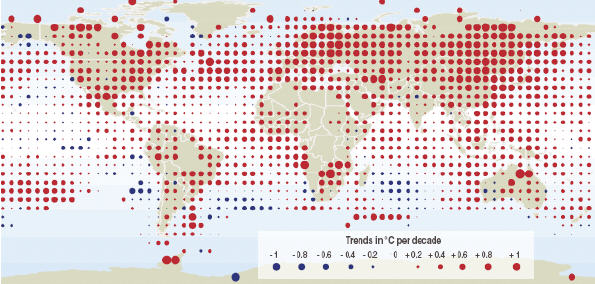Is it really happening?
Climate change and global warming are caused by the so called green-house effect. This effect is due to green-house gases such as CO2 and HFC, which reflect the sunlight that has been bounced off the surface of the planet back to the earth. Since this way more sunlight reaches the surface of the earth, it causes an increase in temperatures, just as it is the (desired) case in a small scale green-house.
Over the past 100 years, the concentration of CO2 in the atmosphere has increased from 280 ppm (parts per million) to around 380 ppm. Analysis of glacier ice shows that the concentration has not been this high in hundreds of thousands of years. This indicates that it is "man-made". At the same time, global temperatures have gone up by about 0,6 degrees Celsius (in the 60s and 70s there was a temporary dip in temperatures due to high concentration of sulphur in the air, caused by coal fired plants - this was subsequently reversed thanks to better filter technologies).
The picture below shows the temperature changes in the last quarter of the 20th century (source: Intergovernmental Panel on Climate Change - IPCC). Direct temperature measurements, satellite data and scientific models confirm that the temperature increase is caused by human activity and not merely due to a change in the angle of the earth on its orbit around the sun, or the sun activity itself.

Is it really so bad?
It is considered a fact that the increase in CO2 concentration is caused by man-made emissions, e.g. by industry, transport, domestic use and agriculture (including deforestation). At the current rate of growth, scientists reckon that the concentration can reach 800 ppm by the end of the century. This would yield a global temperature increase of 3-6 degC.
Already today, the apparently small increase of 0,6 degC over the past 100 years has a strong negative impact on nature. Many glaciers and huge ice shelves are melting, the oceans are getting warmer and sea levels are rising. Rising ocean temperatures cause the deterioration of e.g. coral reefs, and in turn the marine ecosystem. At the same time, certain animal species have to move north to find food, and some are risking extinction due to a lack of it (see the recent reports on starving polar bears). Each of the last ten years has been the hottest year since temperature measurements started. In the Alps as elsewhere, levels of snowfall during the winter have reached new record lows every year. In the Amazon rainforest, droughts in recent years had devastating effects on the ecosystem, leading to a further release of CO2 from dying trees.
What happens when the temperature rises by 3-6 degC is anybody's guess. What is sure is that it is not going to be a pleasant experience for life on earth. While some even think that the Gulf Stream might collapse, the impact will be destructive enough considering only the highly likely effects. To name but a few, sea levels would rise by several meters, drowning entire cities and communities built close to the water, putting the life of millions in danger. Fragile ecosystems in the rainforests and oceans would collapse and whole species of animals would go extinct. Deserts in Africa and Asia will extend dramatically, and there will be a shortage in food supply.
Not only this, but the man-made warming will have other negative reinforcing effects. For instance, the northern Tundra contains huge quantities of frozen CO2 and methane. If temperatures rose, a large portion of that would be released into the air, dramatically increasing the green house effect and causing a further rise in temperatures. The same goes for the oceans, which release more CO2 the warmer they get.
In other words, if particle concentrations and as a result temperatures keep rising, we might soon - definitely within this century - reach a point of no return. Beyond this point, we might not be able to undertake any actions to restore the damage made and contain negative reinforcing effects. Consequences would be dramatic for all forms of life on earth.
What can I do?
Try to live as sustainably as you possibly can. Everyone can make a change and have an impact on fighting global warming, even though it might seem like a negligible contribution. The power lies in many people working towards the same objective. Governments and regulations can provide some support, but the real change has to happen on an individual level.
The various sections of this website give ideas regarding the range of things we can do to keep our planet as beautiful (and cool) as it is. If you only do one thing differently, i.e., in a more environmentally friendly way, after visiting ecowhizz.com, then you have made our day!
